Flags of Austria

The flag of Austria, also known as the “Flag of Austria State,” is a national symbol representing the country of Austria. Here are some facts about the flag of Austria:
- Design: The flag consists of three horizontal stripes of equal width. The top and bottom stripes are red, while the middle stripe is white. The colors red and white have been associated with Austria for centuries and have historical significance.
- Historical Origin: The flag’s design can be traced back to the Middle Ages when the Babenberg dynasty, the ruling family of Austria at the time, used red and white as their coat of arms. The flag’s origin dates back to the 13th century, making it one of the oldest national flags in the world.
- National Emblem: The Austrian flag does not include a national emblem or symbol on its design. However, the red and white colors are often associated with the coat of arms, which features a white shield with a red diagonal stripe.
- State and Civil Use: The flag of Austria is used both as the state flag and civil flag. The state flag is used by government institutions and authorities, while the civil flag is flown by citizens and private organizations.
- Display and Protocol: The flag is prominently displayed on government buildings, official residences, schools, and during national holidays and events. It is also common to see the flag displayed by citizens on their homes during patriotic occasions. The flag has specific protocols for its display, including proper positioning, handling, and folding.
- National Flag Day: Austria celebrates National Flag Day on May 9th each year. This day commemorates the adoption of the flag as a national symbol and is marked by various patriotic events and ceremonies.
- Similar Flags: The flag of Austria is similar in design to the flags of other countries, such as Latvia and Lebanon. However, the shades of red and the aspect ratios of the stripes differ, allowing them to be distinguished from one another.
The flag of Austria is a symbol of national identity, representing the country’s history, heritage, and values. Its simple yet striking design has stood the test of time and is recognized worldwide as a symbol of Austria.